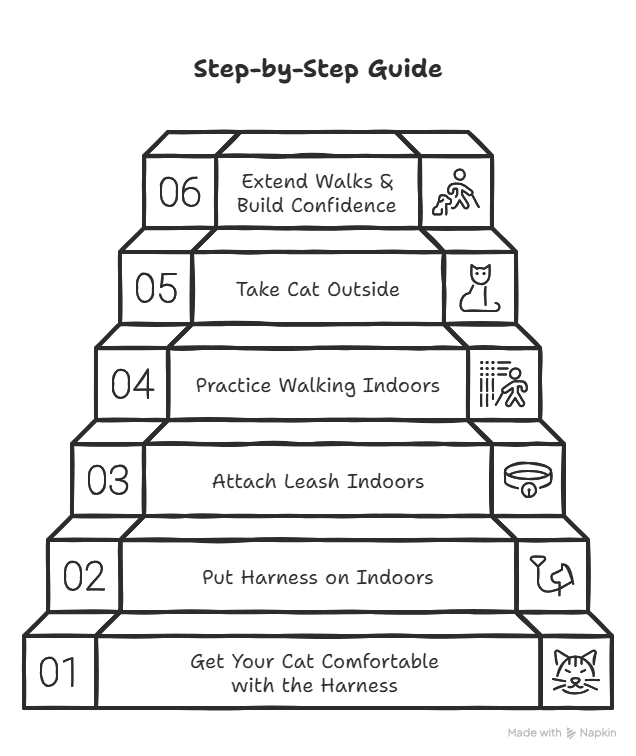
Introduction
Most people think leash training is just for dogs, but guess what? Cats can be trained to walk on a leash too! If you’re wondering how to train your cat to walk on a leash? It’s easier than you might think. Leash training lets your cat safely explore the outdoors, get some exercise, and satisfy their natural curiosity. It’s also great for indoor cats who crave adventure but need a controlled way to experience it.
But here’s the thing: cats aren’t like dogs—you can’t just clip on a leash and expect them to follow you. It takes patience, the right gear, and a step-by-step approach to make leash training a success.
Ready to turn your cat into a confident little explorer? Let’s get started!
🐾 Choosing the Right Gear for Leash Training
Before you start, you’ll need the right equipment.
1. A Secure Cat Harness
🚨 Never use a collar for leash training! Cats can easily slip out of them.
✅ Look for an escape-proof harness that fits snugly but comfortably.
✅ The best harnesses for cats are H-style, vest-style, or figure-8 harnesses.
✅ Make sure there’s enough room for two fingers between the harness and your cat’s body.
🔹 Recommended Harnesses:
- Kitty Holster Cat Harness (vest-style, secure)
- PetSafe Come With Me Kitty Harness (adjustable)
2. A Lightweight Leash
A light, flexible leash (4-6 feet long) works best.
🚫 Avoid retractable leashes—they can startle your cat and are harder to control.
3. Training Treats
Your cat will respond best to positive reinforcement. Use:
✅ Small, soft treats (like freeze-dried chicken).
✅ A clicker (optional) to mark good behavior.
🐱 Step-by-Step Guide to Leash Training a Cat

Step 1: Get Your Cat Comfortable with the Harness
Before even thinking about going outside, your cat needs to get used to wearing a harness.
✔ Leave the harness near their favorite spot so they can sniff it.
✔ Let them rub their face on it (a sign they’re accepting it).
✔ Reward them with treats just for interacting with it.
Time required: 1-3 days
Step 2: Put the Harness on Indoors
Once your cat seems comfortable, gently put the harness on them without fastening it.
✔ Let them wear it loosely for a few minutes.
✔ Give them treats and praise.
✔ Gradually adjust the fit over a few days.
⏳ Time required: 3-5 days
🚨 Common Problem: Your cat flops over and refuses to move? That’s normal! It takes time for them to adjust. Keep sessions short and positive.
Step 3: Attach the Leash & Let Them Drag It Indoors
Once your cat is comfortable in the harness, clip on the leash and let them walk around the house with it trailing behind them.
✔ Supervise them closely to ensure they don’t get tangled.
✔ If they freeze, distract them with treats or play.
✔ Encourage movement by placing treats a few feet away.
⏳ Time required: 3-7 days
Step 4: Practice Walking Indoors
Now, gently pick up the leash and let your cat lead the way inside the house.
🚫 Don’t pull or drag them! Instead, reward them when they take steps forward.
✔ Use a happy voice to encourage movement.
✔ Keep sessions short (5-10 minutes) and end on a positive note.
⏳ Time required: 1-2 weeks
Step 5: Take Your Cat Outside (In a Safe Space)
Now for the exciting part—introducing your cat to the outdoors!
Start in a quiet, enclosed area like:
- A fenced backyard
- A patio or balcony
- A quiet park with no dogs around
✔ Let your cat explore at their own pace.
✔ Keep the first few sessions short (5-10 minutes max).
✔ If they seem scared, bring them inside and try again later.
⏳ Time required: Varies—some cats love it immediately, others need weeks.
Step 6: Gradually Extend Walks & Build Confidence
Once your cat gets used to being outside, slowly increase the duration of walks.
✔ Let them sniff and explore—it’s their walk, not yours!
✔ Always watch for stress signs (flattened ears, tail puffing, crouching).
✔ If your cat seems nervous, end the walk and try again another day.
🚨 Pro Tip: Bring a pet carrier in case they get scared and need a safe retreat.
🐾 Common Leash Training Problems & How to Fix Them
❌ Problem 1: My cat refuses to move!
✅ Solution: Give them more time indoors to adjust to the harness. Use treats to encourage movement.
❌ Problem 2: My cat freaks out and flops over!
✅ Solution: This is normal! Keep training sessions short and let them adjust.
❌ Problem 3: My cat tries to escape the harness!
✅ Solution: Ensure the harness fits snugly and check if it’s escape-proof.
🙋 FAQs
Q1: Is leash training safe for all cats?
✔ Yes, but some cats simply don’t enjoy it—and that’s okay!
Q2: Can I use a regular dog harness for my cat?
❌ No, cat-specific harnesses are designed to fit their unique body shape.
Q3: How long does it take to train a cat to walk on a leash?
✔ 1-3 weeks on average, but some cats need more time.
Q4: What if my cat never wants to walk on a leash?
✔ That’s okay! Some cats prefer indoor adventures like window perches and play tunnels.
Also Read - Why Won't My Cat Use the Litter Box? 10 Reasons & How to Fix It
Final Thoughts
Leash training takes time, patience, and positive reinforcement, but if your cat enjoys it, it’s a great way to give them safe outdoor experiences.
Some cats will love it, while others may prefer to stay inside. Either way, the key is to respect your cat’s comfort level and make training a positive experience.
🐱 Now It’s Your Turn!
Have you tried leash training your cat? Share your experience in the comments! 👇🐾




